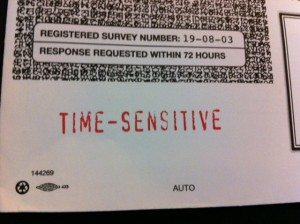 Last week, John Lepp at Agents of Good and FundraiserGrrl Rory Green, inspired by FundraisingYoda, got together and posted a Direct Mail 101, walking readers through some of their go-to suggestions for creating a great direct mail fundraising package -- all with a funny Star Wars theme. Awesome.
The piece was so fun and charming and terrifically clever that I feel terrible objecting to any of it...but in my experience, some of their advice came from the dark side of the Force.
Last week, John Lepp at Agents of Good and FundraiserGrrl Rory Green, inspired by FundraisingYoda, got together and posted a Direct Mail 101, walking readers through some of their go-to suggestions for creating a great direct mail fundraising package -- all with a funny Star Wars theme. Awesome.
The piece was so fun and charming and terrifically clever that I feel terrible objecting to any of it...but in my experience, some of their advice came from the dark side of the Force.
Let me repeat the key part of that last sentence: in my experience.
You see, all direct mail advice should be taken with one of those giant blocks of Himalayan pink salt. What works for your donors may be like sending the Death Star to visit mine. The only way you'll know if you've found the fundraising Force for your donors is to test.
That means, of course, that you have to have data you can read -- more on that next week! -- and a big enough pool of people (or a few months worth of mailing the test). It means you might have to do twice as much work on a few mailings. But that will be worth it when you discover what really works for YOUR donors...not just what works according to experts like me.
So, what was the Direct Mail 101 advice you'd never catch me giving?
On the Outer Envelope
- Should be almost anything other than a white, #10 envelope with a window (or whatever the standard size that 99% of charities are using in your country). This is a 9″ x 6″.
Not in my experience. Several of my clients have tested 9x6 envelopes...all have failed spectacularly. Nearly all of my clients have tested colored outers...which performed no better or worse than a standard white envelope. I've had far bigger boosts from testing various teasers and design treatments than stock colors.
Now, to be totally honest, a 9x12 envelope did routinely beat a #10 for one of my clients, but the cost became so prohibitive that it negated the improved results.
Standing out in the mail is a noble goal and could possibly bump up your revenue and response. But it might not.
Bottom line: if 99% of charities are doing something...it's probably working for a lot of them.
- No window usually beats having a window on your envelope. Windows subconsciously say “bill”.
Again, a couple of my clients have tested this over and over again, convinced that the conventional wisdom that says a closed OE will out-perform a window must be true for them, too. And while a few of those tests have fallen in favor of the closed OE, the tepid results simply couldn't compensate for the increased costs. And most of the tests were decided in the window OE's favor.
There are some nuances here, and my two biggest clients continue to test variations on this, hoping to discover when it's worth the added expense of a closed outer, and when a window with a screaming teaser is the best option. I'll let you know if we discover anything definitive.
One last thought: what's so bad about looking like a bill? I don't know about you, but I don't open all of my mail...but I do open all of my bills.
On the Letter
- Font: courier. As big as possible – 13 point here. Courier is likely one of the most – if not THE most effective font in direct mail. It works! I can practically hear the letter writer sitting in the dark quickly hammering this out on her typewriter.
Again, been there, tested that. Courier and Times New Roman performed equally well every single time, over multiple tests. (We just couldn't believe the results, so this test was repeated several times!) I will say that font size did make a difference for one of my clients whose list runs older than most. But even though we thought Courier would be a hit with those older folks, it didn't make a lick of difference.
Elsewhere in the Package
No mention of the reply envelope.
UPDATED: the reply envelope was added in after I read the post with spot-on fantastic advice!
This was one component they left off their tutorial completely -- and although it's tempting to treat the reply envelope as an afterthought, I'd urge you not to. Whenever I can, I try to include a message on the RE -- usually in the upper lefthand corner, depending on postal regs -- that reiterates both the urgency and the contents of the ask. (RUSH: Petitions Enclosed is a favorite with my activist clients.)
If you can, address the RE to a person at the organization. If you're using a BRE that won't be possible, but with an RE you can include your letter signer's name above the address, which makes your donor feel more like they're communicating with a person and not an institution.
When you're using a BRE, a "Your stamp saves us money" message really can save you money on postage costs -- and just might up response, as well.
NOTE: John tells me that there's been substantial testing refuting this, and I trust that. I have a client who has had success with it, but I prefer to use the space for a more ask-oriented message anyway.
Trust the Force.
I'm being nit-picky here. Most of the advice John and Rory compiled was stellar and matches my experience. And delivered in a fun, friendly, fantastic way. Plus, YODA! Honestly, I loved it.
And while my experience might have diverged from theirs in those few specific areas that I cited, that doesn't mean that yours will. In fact, I urge you to try all of their suggestions -- and you can bet that I'll be recommending that a few of my clients revisit these ideas down the road. As lists, tastes and fashions evolve, it's important to keep evaluating what works best.
No matter what advice you're getting, the most important thing is to make sure that it works for YOUR unique set of donors. Test, test, test. Even with a tight budget, pay attention to what YOUR donors want, and keep the rest of the advice in your back pocket. Then you will truly be using the Fundraising Force.
 This past week we did a lot of rushing in my family. From piano to birthday celebrations, from haircut to dinner to middle school tour, from futsal to more birthday celebrations…it was a whirlwind.
As we rushed from activity to activity, I also did some rushing in my work life. And it got me thinking about how compressed our schedules have become in the last few years. What used to be a six week process of strategy-research-outline-draft-refine-review-perfect-mail has, too often, become a mad dash from outline to draft to review to mail -- with no time to strategize, thoroughly research, refine or perfect anything.
This past week we did a lot of rushing in my family. From piano to birthday celebrations, from haircut to dinner to middle school tour, from futsal to more birthday celebrations…it was a whirlwind.
As we rushed from activity to activity, I also did some rushing in my work life. And it got me thinking about how compressed our schedules have become in the last few years. What used to be a six week process of strategy-research-outline-draft-refine-review-perfect-mail has, too often, become a mad dash from outline to draft to review to mail -- with no time to strategize, thoroughly research, refine or perfect anything.



















